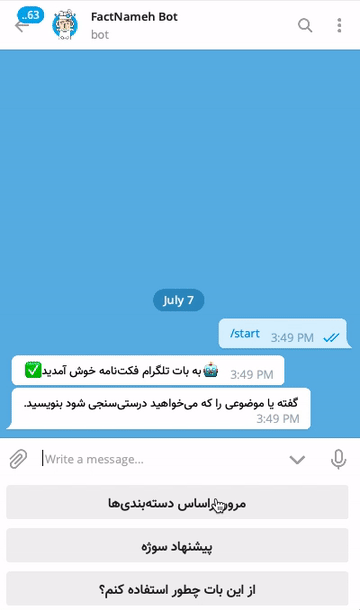How We're Using Technology to Counter Misinformation

Weeks ago, we received a tip about misinformation circulating on a private Telegram channel. This was during the height of the pandemic and we had already grown accustomed to reading about all sorts of misinformation and fake COVID-19 remedies online. But this was different. This channel had 35,000 members who were inundated with a large volume of pseudoscientific claims and fake remedies on a near daily basis.
Soon, we learned that this closed network is run by a few admins with little patience for dissent. Anyone who questioned the pseudoscientific inventions and “medical” advice of the “professor” was immediately kicked out of the group, a fate that naturally befell us when we shared our fact-checks.
Iran, like many other countries, is dealing with a rising flow of misinformation. Lack of press freedom and online censorship further limits access to fact-based reporting and journalism. As a result, messaging applications like Telegram have turned into major sources of information. Features like public channels that make them so popular are perfect for spreading misinformation, such as the ability to create private channels with up to 200K members, where admins moderate content and have the power to create closed networks where misinformation can reach large audiences.
With social media platforms and technology aiding the spread of misinformation through bots, trolls, and manipulation of social media algorithms, our team at Factnameh, who focus on countering misinformation in Persian media through fact-checking, have been exploring the use of tech tools to support our work. Using a Telegram bot to combat misinformation has been an old idea, and with trends like this, it became more and more urgent to revisit the idea of using tech tools to combat misinformation more effectively.
Today, we are excited to launch our Telegram bot, as one of the many ways we are thinking of using technology to support our fact-checking efforts.
In its first phase, the bot will bring our fact-checks to readers on Telegram across six popular categories, and help improve our interactions with our users. More than 50% of our fact-checks are currently produced in response to user requests, and majority of these are through Telegram. The bot will make it easier for users to submit content for fact-checking.

The use of technology to support fact-checking is not unique to us. Regional and country-specific fact-checkers like Africa Check, Chequeado and Full Fact as well as The Reporters’ Lab at Duke University have developed creative platform-specific content and automated fact-checking to improve and scale fact-checking efforts. In response to misinformation related to COVID-19, the International Fact-checking Network also launched a WhatsApp chatbot and the World Health Organization has also introduced its own WhatsApp bot.
In future, we hope to expand the bot to enable users to send tips about private groups spreading misinformation such as the one we encountered, so that we can track, join and counter misinformation within these closed networks at scale. This will also provide us with interesting data on trends, and perhaps suggest new approaches or tools that could make it easier for fact-checkers to respond to misinformation, particularly on closed networks and messaging applications.
As long as social media continues to serve as the battleground in this information war, we will need to experiment with different tech tools and approaches to come up with new innovative, automated and scalable technological solutions to help our fact-checkers keep up.
